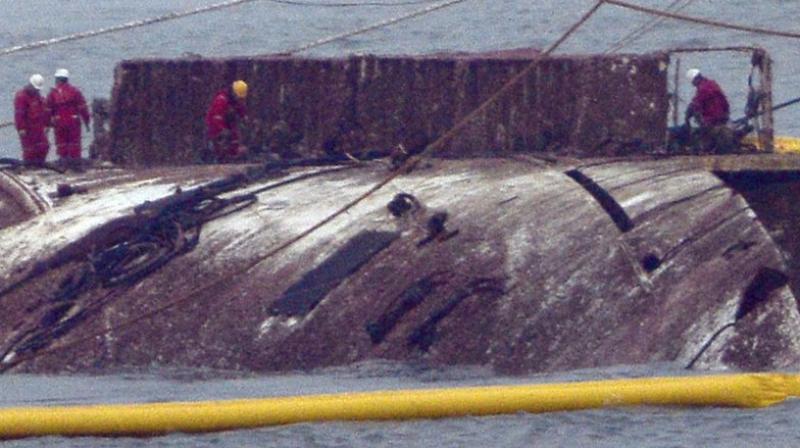South Korean ferry that sank 3 years ago lifted from sea

Seoul: A 6,800-ton South Korean ferry emerged from the water on Thursday, nearly three years after it capsized and sank into violent seas off the country's southwestern coast, an emotional moment for the country that continues to search for closure to one of its deadliest disasters ever.
More than 300 people — most of whom were students on a high school trip — died when the Sewol sank on April 16, 2014, touching off an outpouring of national grief and soul searching about long-ignored public safety and regulatory failures. The public outrage over what was seen as a botched rescue job by the government contributed to the recent ouster of Park Geun-hye as president.
Workers on two barges began the salvaging operation Wednesday night, rolling up 66 cables connected to a frame of metal beams divers spent months putting beneath the ferry, which had been lying on its left side in about 44 meters (144 feet) of water.
By 3:45 a.m., Sewol's stabilizer surfaced from the water. About an hour later, the blue-and-white right side of ferry, rusty and scratched and its name "SEWOL" no longer visible from where it was, emerged for the first time in more than 1,000 days.
By about 7 a.m., the ferry had been raised enough for workers to climb on it and further fasten it to the barges. Lee Cheoljo, an official from the Ministry of Oceans and Fisheries, told reporters that workers will need until late afternoon or the evening to raise the ferry until its upper side is about 13 meters (42 feet) above the surface.
Workers had initially planned to do this by Thursday morning, but were forced to a temporarily halt when the ferry began rubbing against pulleys and other equipment on the barges as it came up, Lee said. He said workers will resume lifting the ferry once they finish balancing operations that could take several hours.
Once Sewol is raised to the desired point, salvage crews will then load the ferry onto a semi-submersible, heavy-lift vessel that will carry it to a mainland port. The loading process, including emptying the ferry of water and fuel, is expected to take days.
The bodies of 295 passengers were recovered after the sinking on April 16, 2014, but nine are still missing. Relatives, some of whom who are watching from two fishing boats just outside the operation area, are hoping that those remains will be found inside the ferry.
"I can see it. I can see where my daughter is," Park Eun-mi, the mother of a missing 17-year-old girl, told a television crew as her boat approached the salvaging site on Wednesday. Lee Geum-hee, the mother of another missing student, said, "We just want one thing — for the ship to be pulled up so that we can take our children home."
Once the ferry reaches a port 90 kilometers (55 miles) away in the city of Mokpo, in about two weeks, workers will begin clearing the mud and debris and search for the remains of the missing victims. An investigation committee will also be formed to search for clues that could further explain the cause of the sinking, which has been blamed on overloaded cargo, improper storage and other negligence.

